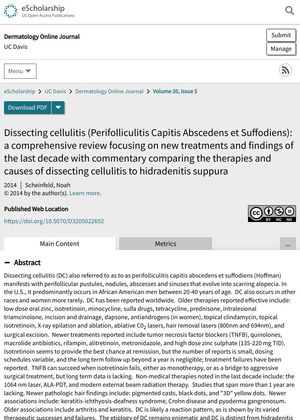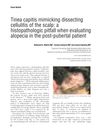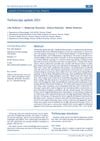Dissecting Cellulitis (Perifolliculitis Capitis Abscedens et Suffodiens): A Comprehensive Review Focusing on New Treatments and Findings of the Last Decade with Commentary Comparing the Therapies and Causes of Dissecting Cellulitis to Hidradenitis Suppurativa
January 2014
in “
Dermatology Online Journal
”
Dissecting cellulitis scarring alopecia low dose oral zinc isotretinoin minocycline sulfa drugs tetracycline prednisone intralesional triamcinolone incision and drainage dapsone antiandrogens topical clindamycin topical isotretinoin X-ray epilation ablative C02 lasers hair removal lasers surgical excision tumor necrosis factor blockers quinolones macrolide antibiotics rifampin alitretinoin metronidazole high dose zinc sulphate 1064 nm laser ALA-PDT external beam radiation therapy Accutane Minocin Bactrim Sumycin Deltasone Kenalog Aczone Cleocin X-ray hair removal CO2 laser laser hair removal TNF blockers Cipro Zithromax Rifadin Panretin Flagyl high dose zinc Nd:YAG laser Photodynamic therapy radiation therapy

TLDR New treatments for Dissecting cellulitis show promise, but more research is needed to understand the disease and establish a standard treatment plan.
A decade ago, the study reviewed the condition known as Dissecting cellulitis (DC), a form of scarring alopecia predominantly found in African American men aged 20-40. Various treatments were reported effective, including low dose oral zinc, isotretinoin, minocycline, sulfa drugs, tetracycline, prednisone, intralesional triamcinolone, incision and drainage, dapsone, antiandrogens (in women), topical clindamycin, topical isotretinoin, X-ray epilation and ablation, ablative C02 lasers, hair removal lasers (800nm and 694nm), and surgical excision. Newer treatments included tumor necrosis factor blockers (TNFB), quinolones, macrolide antibiotics, rifampin, alitretinoin, metronidazole, and high dose zinc sulphate (135-220 mg TID). Isotretinoin provided the best chance at remission, but long-term data was lacking. Non-medical therapies included the 1064 nm laser, ALA-PDT, and modern external beam radiation therapy. The etiology of DC remained unclear, and it was distinct from hidradenitis suppurativa. The incidence of DC was likely under-reported, and while most cases could be treated effectively, the lack of clinical studies limited the understanding of the disease and the ability to define a consensus treatment algorithm.



